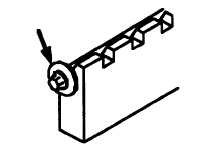| |
TM 10-3930-671-24
Do not operate a lift truck with damaged or missing
decals and nameplates. Replace them immediately.
They contain important information.
1.
First, perform a visual inspection of the truck and
its components. Walk around the truck and take
note of any obvious damage and maintenance
problems. Check for loose fasteners and fittings
and loose sheet metal.
2.
Be sure to make a thorough inspection of the
critical components that handle or carry the load.
3.
Check to be sure all capacity, safety, and
warning plates or decals are attached and
legible.
4.
Inspect the truck, before and after starting
engine, for any signs of external leakage: fuel,
engine coolant, transmission fluid, etc.
5.
Check for hydraulic oil leaks and loose fittings.
Do not use bare hands to check. Oil may be hot
or under pressure.
Overhead Guard, Load Backrest, Fork Retainers
1.
Be
sure
overhead
guard,
load
backrest
extension, finger guards, and any other safety
devices are in place, undamaged, and attached
securely.
2.
Check overhead guard for damage. Be sure it is
properly positioned and all mounting fasteners
are in place and tight.
3.
Check load backrest for damage. Inspect the
welds on the carriage and load backrest for
cracks. Be sure that the mounting fasteners are
all in place and tight.
4.
If load backrest has been removed, a bolt and
washer must be in place on each end of the top
fork bar to act as a fork stop.
Upright and Lift Chains
NOTE
Uprights and lift chains require special attention and
maintenance to maintain them in
safe
operating
condition.
1.
Inspect the upright assembly: rails, carriage
rollers, lift chains, lift and tilt cylinders.
•
Look for obvious wear and maintenance
problems, and damaged or missing parts.
•
Look for any loose parts or fittings. Check
for leaks, any damaged or loose rollers,
and rail wear. Check for metal flaking in
the roller pathways.
•
Carefully check the lift chains for wear,
rust and corrosion, cracked or broken
links, stretching, etc.
•
Check that the lift chain anchor fasteners
and locking means are in place and tight.
•
Check and adjust fork height to prevent
fork wear.
2. Be sure all safety guards and chain retainers are
in place and not damaged. Inspect the carriage
stops and cylinder retainer bolts. Check all
welded connections.
3. Inspect all lift line hydraulic connections for
leaks.
4. Check the lift cylinder rods for wear marks,
grooves, and scratches.
5. Check the cylinder seals for leaks.
F-42
|



